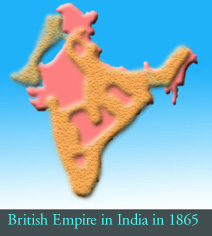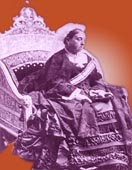
British Governors and Governor Generals (continued...)
Lord Dalhousie (1848-56)
 Lord Dalhousie was appointed
Governor General of India in 1848. His eight years of rule is considered one of
the greatest period of British rule. His policy of Annexation was a lethal
weapon of conquest which raised the rule of the East India Company to the height of
glory. It was also during his rule that various reforms were brought to improve
the conditions of India. Though these directly benefited the British yet they
were foundations on which the country built itself after
independence. The policy of annexation known as the Doctrine of Lapse was based
on the forfeiture of the right to rule in the absence of a natural heir. By this
policy the state of Satara was annexed in 1848, in 1849 the state of Sambhalpur
and in 1853 Jhansi was also annexed. After the death of the Raja of Nagpur in 1853 the policy
claimed yet another victim. By 1854 owing to the failure to have a natural heir
Nagpur too was annexed.
Lord Dalhousie was appointed
Governor General of India in 1848. His eight years of rule is considered one of
the greatest period of British rule. His policy of Annexation was a lethal
weapon of conquest which raised the rule of the East India Company to the height of
glory. It was also during his rule that various reforms were brought to improve
the conditions of India. Though these directly benefited the British yet they
were foundations on which the country built itself after
independence. The policy of annexation known as the Doctrine of Lapse was based
on the forfeiture of the right to rule in the absence of a natural heir. By this
policy the state of Satara was annexed in 1848, in 1849 the state of Sambhalpur
and in 1853 Jhansi was also annexed. After the death of the Raja of Nagpur in 1853 the policy
claimed yet another victim. By 1854 owing to the failure to have a natural heir
Nagpur too was annexed.
Another method of annexation was by conquest. In 1849 Punjab was annexed after the Second Anglo Sikh War. In 1852 after the Second Burmese Lower Burma known as Pegu was annexed. In 1850 part of the state of Sikkim was annexed on the pretext of maltreatment of English officials. Other territories were annexed on the grounds of misgovernment and Assignment.To this policy fell the territories of Berar in 1853 and Oudh in 1856.
Dalhousie proved his worth in the matters of administration by the demarcation of various departments of the administrative machinery and appointment of Lieutenant Governor for Bengal. He introduced the non-regulation system under which the non-regulation provinces was to be under a Chief Commissioner responsible to the Governor-General in council. Punjab, Oudh, Burma were a few non-regulating provinces.
Dalhousie introduced Railways and Telegraph in India with a purpose to improve communication which was essential to administer the far flung areas of this vast country. He also reformed the postal system. To undertake works for the public benefit he introduced the public works department. In the educational field ,Dalhousie's reforms such as the system of vernacular education was praise worthy. Anglo Vernacular Schools were established. In the matters of commerce the policy of free trade was introduced by declaring free ports. Indian trade by now was dominated by the English. The military reforms of Dalhousie included the shift of the Bengal Artillery from Calcutta to Meerut. The Army head quarter shifted to Simla from Calcutta. Sensing the dangers of the increasing Indian troops he proposed reduction of Indian soldiers. He encouraged the inclusion of Gorkhas to the Indian Army; and organised an irregular force for Punjab.
Dalhousie policy of annexations and reforms only appealed to the English interests in India and this is said to have created the grounds for a rise of the Indian opposition which reflected as the mutiny of 1857. Though started by the sepoys of the Indian army, it gave an opportunity for the discontent Indian rulers to express their discontent. It also was an attempt aimed at erasing the British rule in India. Before the revolt of 1857 several revolts preceded reflecting the Indian opposition to the British domination. They included the Sanyasi revolt of 1770, the Chuar and Ho rebellion of Midnapur in 1768, 1820-22 and 1831. They continued their stand against the British till 1837. The Santhals of Rajmahal hills rebelled in 1855. In 1828 and 1830 the Ahoms in Assam rebelled against the company followed by the Khasi's in the Jaintia and Garo hills.
In 1817-19 the Bhils of the Western Ghats revolted and continued their struggle in 1831 and 1846. The rulers of the Kutch, the Wagheras of Okha Mandal, the Ramosis also revolted against the British. In South India the Raja of Vizianagram, the Poligars of Dindigul and Malabar rose in 1856. The imposition of the subsidiary alliance of 1805 on the ruler of Travancore led to the rise of Diwan Velu Tampi with the Nair battalion.
The revolt of 1857 broke out
owing to political, administrative and economic causes besides the social and
religious causes. The discontented sepoys of the British army were fuelled by the
immediate reason, said to be the use of the greased cartridges. An infuriated
sepoy Mangal Pandey is said to have shot dead a n officer leading to punishment
and disbanding of the soldiers of that regiment. The revolt spread to the North
Central part of India. Owing to poor organisation and superiority of the British
forces the revolt was subdued.
n officer leading to punishment
and disbanding of the soldiers of that regiment. The revolt spread to the North
Central part of India. Owing to poor organisation and superiority of the British
forces the revolt was subdued.
The revolt of 1857 was followed by several changes that included the transfer of Indian administration from East India Company to the crown, respect of the honour, dignity and territorial possession of the native princes. Thus the revolt witnesses the end of an era of the rule of the few in the company. It also marked the beginning of an organised struggle for freedom from the British yoke.
Lord Lytton (1876-80)
Lord Lytton took charge in 1876. Though he had excelled as a poet, a novelist and essayist, he was not an able administrator. He brought reforms in trade bringing the policy of free trade. His policy towards the Afghans led to the second Afghan war. The Criticisms of the British policy led to the passing of the Vernacular press Act in 1878 and Indian Arms Act. In the field of financial reforms he brought reduction of Import duties, financial decentralization and equality of tax duties.
During 1876-78 a severe famine affected Madras, Bombay, Mysore and Hyderabad. In 1878 a Famine commission was appointed. Lord Lytton's rule was unpopular.
| Back | More |






